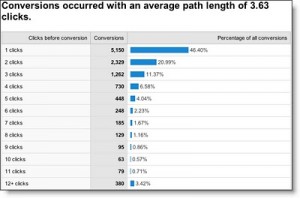Even though Google AdWords has just celebrated its tenth birthday- a long time in internet years- the pace of innovation over the last year shows no signs of slowing down. We have been using the following brand new features extensively this year and have seen some great results. The ability firstly to get more conversions- sales, leads and customer enquiries for our clients and secondly the ability to measure return on investment more accurately are the most important features of AdWords for us and our clients, and in both of these areas we have seen some significant improvements.
1. Search Funnels: Attributing the value of a conversion to which visit (first, last or a combination of all visits) is a challenge faced by online marketers (not overlooking the offline influence too!). The default setting in AdWords is to allocate conversions to the last click on an AdWords ad over a 30 day period if any conversion happened subsequently by that visitor (although this can be adapted). However there is now a wealth of information available in the search funnel reports allowing us to understand the customer journey better- click-assisted conversions, impression- assisted conversions and top paths (i.e. which campaigns, ads, keywords etc the visitor clicked before converting). This information has been invaluable for us in optimising campaign structures and allocating budgets and also helps us understand better what leads up to a conversion. It is worth remembering that a visitor may come to your site 10 times or more before buying a product.
2. Ad Extensions: Ad extensions (location extensions, such as a local shop address; phone extensions, product extensions, showing images linked from the Merchant account and sitelinks, links to various pages on the site) have allowed us to increase clicks, conversions and ROI. Click through rates have improved by 30% or more when these ad extensions are visible. These ad extensions are not always shown and are more of a reward for top advertisers- an incentive not to raise bids but to concentrate even more on improving quality scores.
3. Seller Ratings: This new ad extension deserves a section of its own and shows the importance that Google- not just web visitors- is placing on review content (which is cropping up everywhere- Google Product Search and Google Places pages for example). Seller Ratings are the stars that appear beneath certain ads- linked to reviews on Google Product Search. A company has to have at least 30 reviews and a rating of four stars or above which are aggregated from third party sites or Google Checkout. Again, seller ratings only appear for the top advertisers (if at all)- a further incentive to boost quality scores. Where we have used seller ratings, we have seen a noticeable difference not just in CTR but also in conversion rates. Conveying trust remains one of the most important elements of converting visitors and customer reviews are undoubtedly a central part of this.
4. AdWords Campaign Experiments: We are used to testing all elements of our online campaigns and websites using e.g. Google Website Optimizer for A/B and multivariate tests but previously we tested AdWords campaign elements on a less sophisticated basis e.g. “on” or “off” on an hourly or daily basis, rather than testing different elements simultaneously. Now we can get far more accurate results (rather than incorporating other factors such as differing times of the day or days of the week) from our tests. This really is the secret to all our online marketing campaigns- extensive testing- and with this feature there are now no excuses not to be doing so.
5. Remarketing: Judging by the amount of new features over the last year, the Display Network (formerly Content Network) is becoming increasingly a priority for Google (and accounts for a growing proportion of their revenues, along with advertising on Youtube, as seen in Google’s last quarterly reports). Lots of advertisers that we speak to have had bad experiences with the display network in the past (very low CTRs, few or no conversions) but new features such as view-through conversion tracking have shown the benefits. AdWords Remarketing we have seen to be particularly effective for certain advertisers (high-end retail products for example) and although the display banners do not show actual products you have looked at (unless you set up a different banner for each product page) similar to some of the more advanced products in this area such as Criteo, we can assume that Google will be moving increasingly in this direction. The cost per acquisitions we have been achieving using remarketing have been similar (and in some case lower) than those on the search network.
6.AdWords Automated Rules: There are a number of tools in AdWords that let Google decide what is best (which ads are displayed or what bids for example)- generally though we prefer to make our own decisions for optimising campaigns (with plenty of help from Google Analytics, Excel and AdWords Editor). One major exception to this is AdWords Automated Rules, a new feature which allows us to set up a range of rules based on our own knowledge of campaigns, such as when to increase bids automatically at peak times for example. This is a very useful new feature which we have been using extensively for optimisation of our campaigns.
7. Enhanced CPC: Our experience using Conversion Optimizer (cost per acquisition bids, rather than cost per click bids) has been mixed- in quite a number of situations we have reverted back to CPC bidding. Enhanced CPC, which allows bids to be automatically raised by up to 30% by Google based on knowledge from the campaign about when conversions are most likely to occur, has seen to be very effective where we have used it.
8. Broad Match Modifier: This new match type (in between broad match and phrase match) has worked very well for us in certain campaigns- we do use broad match types particularly for long-tail type phrases (a phrase of three or four keywords for example) but using broad match modifier has helped us maintain that extra bit of control without using phrase matching instead.
9. Call tracking: Using call tracking in association with our AdWords campaigns have led to a marked improvement in ROI. We have seen subtle differences in the types of keywords used by people that prefer to call (rather than buy online or submit an online enquiry form for example) and we have used this knowledge to help optimise our campaigns. We have been using AdInsight Clarity for this purpose, which is very straightforward to use and simple to integrate with both AdWords and Analytics. It is worth noting that Google have begun trialling their own call tracking software in the US (integrating AdWords with Google Voice).
10. AdWords API- Using the latest AdWords API release, our developers have this year built a system that can turn the XML product feed of an online retailer into ads automatically, including keyword creation. When a retailer has thousands of products (which are constantly going in and out of stock with prices also changing) it is very important to only display the correct product ads (rather than one for a product that is out of stock or for which the price has changed). The AdWords API has therefore helped us take advantage of the most relevant traffic for products that our clients are offering.
If you have any comments about your experiences with these features, or any of the other new AdWords features, please let us know in the comments below.




No Comments